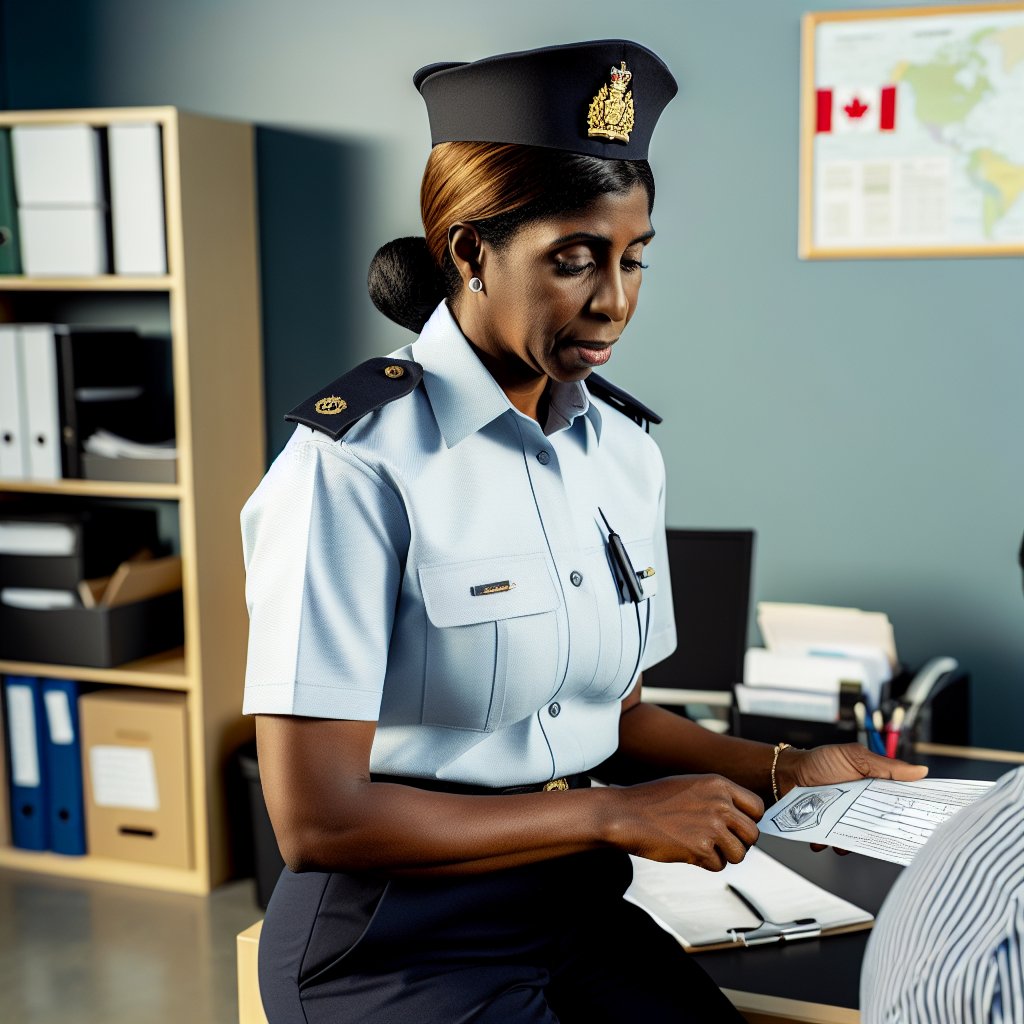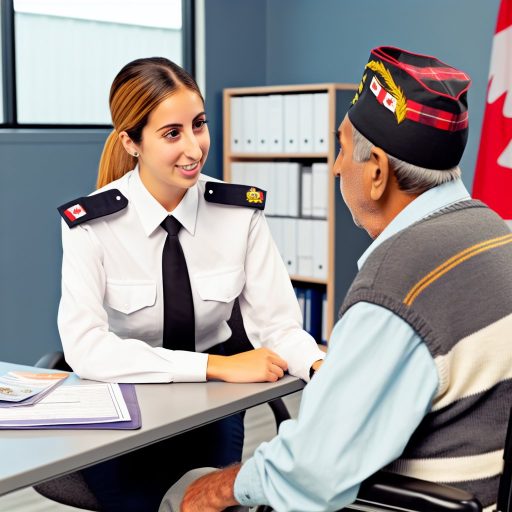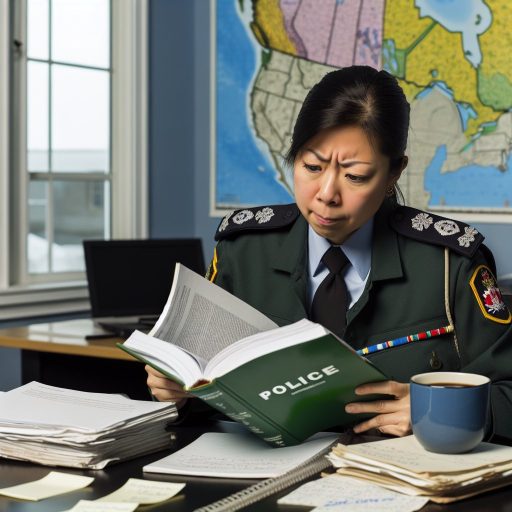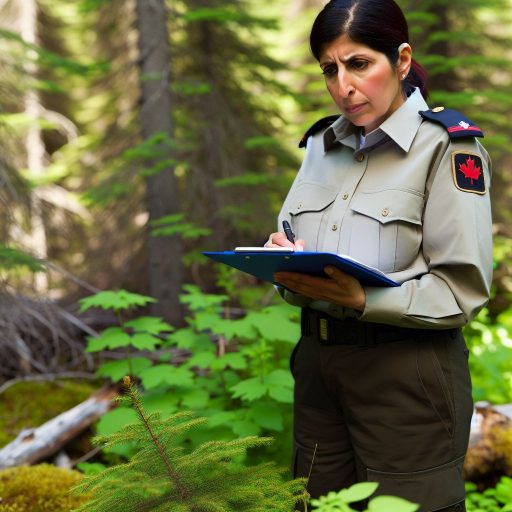Overview of the Border Services Officer Role
A Border Services Officer plays a crucial role in national security.
This officer ensures the safety of borders and prevents illegal activities.
They facilitate legitimate trade and travel across borders.
Overall, their duties aim to protect the integrity of the country.
Primary Responsibilities
Border Services Officers monitor entry points into the country.
They conduct inspections of travelers and goods.
Additionally, they enforce customs and immigration laws.
This includes assessing documentation and conducting interviews.
Officers also detect and prevent smuggling of goods.
Collaboration with Other Agencies
Collaboration is essential for effective border management.
Border Services Officers work with law enforcement agencies.
They also partner with health and agriculture departments.
This cooperation enhances the flow of information and resources.
Such collaboration ensures a unified response to security threats.
Training and Skills Required
Training is critical for Border Services Officers.
They undergo rigorous training in enforcement techniques.
Officers develop skills in communication and problem-solving.
Additionally, they learn about cultural sensitivity and ethics.
Ongoing training ensures they remain updated on policies.
Importance in Society
Border Services Officers contribute significantly to public safety.
They help maintain order while facilitating travel and trade.
Moreover, their work builds public trust in government processes.
Ultimately, they play a vital role in national stability.
Key Responsibilities in Immigration Control
Monitoring Border Crossings
Border Services Officers monitor all border crossings effectively.
They ensure compliance with immigration laws and regulations.
Unlock Your Career Potential
Visualize a clear path to success with our tailored Career Consulting service. Personalized insights in just 1-3 days.
Get StartedOfficers conduct thorough checks on all individuals seeking entry.
They assess documentation and verify identities meticulously.
Moreover, they identify potential security threats during inspections.
Conducting Investigations
Investigations form a significant component of their role.
Officers investigate suspicious activities related to border security.
They gather evidence and conduct interviews when necessary.
Additionally, they collaborate with law enforcement agencies.
This teamwork enhances overall security and intelligence sharing.
Educating the Public
Border Services Officers educate the public about immigration policies.
They provide guidance on required documentation for travel.
Officers also conduct outreach programs in local communities.
This helps raise awareness about border regulations.
Furthermore, they address misconceptions and promote compliance.
Implementing Security Measures
Security measures are pivotal in their daily tasks.
Officers implement state-of-the-art technology at checkpoints.
They utilize biometric systems to enhance identification processes.
In addition, regular training keeps them updated on best practices.
This continuous improvement bolsters border security efforts.
Collaborating with International Agencies
Collaboration with international agencies is crucial for success.
Officers share intelligence with global counterparts regularly.
This cooperation helps combat transnational crime more effectively.
Moreover, it fosters strong relationships with foreign governments.
Such partnerships contribute to enhanced global security frameworks.
Enforcement of Customs Regulations
Overview of Customs Regulations
Customs regulations govern the movement of goods across borders.
They ensure that all imports and exports comply with the law.
Moreover, they protect national security and public health.
Roles of a Border Services Officer
A Border Services Officer enforces these customs regulations.
They inspect cargo and verify documentation at ports of entry.
In addition, they assess duties and taxes on imported goods.
Furthermore, they identify and prevent smuggling activities.
Inspection Procedures
Officers use various methods to conduct inspections effectively.
They may employ X-ray machines to scan containers quickly.
Additionally, they conduct physical examinations on suspicious shipments.
These procedures help in detecting prohibited items and contraband.
Collaboration with Other Agencies
Border Services Officers work closely with other government agencies.
This collaboration ensures consistent enforcement of regulations.
Agencies include law enforcement and health departments.
Additionally, officers share information with international customs agencies.
Training and Development
Training is essential for Border Services Officers to perform their duties well.
They must stay updated on the latest regulations and technologies.
Ongoing education enhances their ability to detect smuggling tactics.
Officers also learn how to handle sensitive situations professionally.
Discover More: Challenges Faced by Correctional Officers in Canada
Inspection Procedures and Techniques
Overview of Inspection Procedures
Border Services Officers play a crucial role in maintaining security.
They inspect goods and people crossing the border.
This process prevents illegal activities and ensures compliance.
Officers must utilize effective inspection techniques to achieve their goals.
Utilizing Technology in Inspections
Modern technology enhances border inspections considerably.
X-ray machines help officers identify prohibited items.
Body scanners assist with detecting concealed contraband.
Furthermore, surveillance systems monitor busy areas effectively.
Manual Inspection Techniques
Officers often conduct manual inspections alongside technology.
They perform thorough checks of luggage and vehicles.
During these inspections, attention to detail is vital.
Officers look for signs of tampering or unusual behavior.
Engaging with Travelers
Effective communication is essential during inspections.
Officers engage with travelers to gather information.
They ask questions to assess the legitimacy of travel plans.
Active listening helps identify potential security risks.
Teamwork and Coordination
Collaboration among officers enhances inspection effectiveness.
Teams often conduct joint operations to maximize safety.
Communication between agencies further strengthens security measures.
Coordination is necessary during large-scale events or busy travel seasons.
Continuous Training and Adaptation
Ongoing training is crucial for Border Services Officers.
They must stay updated on the latest security protocols.
Adaptation to new threats ensures effective inspections.
Regular drills help officers refine their skills and techniques.
Discover More: Correctional Officer Roles and Responsibilities Explained
Collaboration with Law Enforcement Agencies
Importance of Collaboration
Border Services Officers work closely with law enforcement agencies.
This collaboration enhances national security efforts.
It also improves the effectiveness of immigration control.
Law enforcement agencies provide critical intelligence information.
Officers share important data to apprehend wanted criminals.
Coordination on Operations
Joint operations allow for a unified approach to border control.
Border Services Officers coordinate arrests with local police departments.
This coordination extends to federal agencies such as the FBI and DEA.
Effective communication is vital during these operations.
Training and Support
Training programs often include insights from law enforcement experts.
Border Services Officers participate in joint training exercises.
These sessions strengthen skills in various enforcement scenarios.
Additionally, specialized training addresses emerging threats.
Information Sharing
Information sharing is crucial for identifying smuggling operations.
Agencies use secure systems to exchange intelligence regularly.
This practice ensures timely responses to security threats.
Furthermore, collaboration improves evidence collection practices.
Community Engagement
Border Services Officers engage with community policing initiatives.
These outreach efforts build trust between officers and local communities.
Community involvement aids in gathering public intelligence.
This collaboration fosters a safer environment for all residents.
Discover More: Career Longevity Tips for Canadian Correctional Officers

Understanding and Implementing Border Security Policies
Overview of Border Security Policies
Border security policies play a vital role in national security.
These policies establish guidelines for preventing illegal activities.
They aim to regulate the flow of goods and individuals across borders.
Border services officers enforce these policies daily.
Consequently, their work directly impacts national safety and economy.
Key Responsibilities of Border Services Officers
Border services officers are responsible for inspecting documents.
They assess the legitimacy of travelers and cargo.
Additionally, they monitor border crossings for any illegal activities.
Officers use various technological tools to aid in their inspections.
Collaboration with other agencies enhances their effectiveness.
Training and Qualifications
Proper training is essential for border services officers.
They undergo rigorous education on security protocols.
Furthermore, officers receive training in customer service skills.
These skills help them handle diverse situations effectively.
Continuous learning keeps them updated on evolving threats.
Challenges Faced by Border Services Officers
Border services officers face numerous challenges daily.
High traffic volumes require quick decision-making abilities.
They must remain vigilant against evolving smuggling tactics.
Dealing with distressed individuals can be emotionally taxing.
Moreover, they often work under significant pressure.
Importance of Compliance with Policies
Compliance with border security policies is crucial for safety.
It helps maintain the integrity of the national borders.
Every officer plays a role in upholding these standards.
This compliance also fosters trust among the public.
Ultimately, it supports effective law enforcement efforts.
Uncover the Details: Ombudsmen and Their Impact on Consumer Protection
Handling Situations with Non-Compliance or Violations
Identifying Non-Compliance
Border services officers must remain vigilant in identifying non-compliance.
This includes recognizing suspicious behavior at checkpoints.
Also, officers should be aware of inconsistencies in documentation.
Proactively asking questions can help clarify unclear situations.
Initial Response Protocol
Upon detecting a violation, officers must act promptly and professionally.
The initial response should involve calmly addressing the individual.
Clearly explain the observed non-compliance and its implications.
Officers should document all interactions thoroughly for record-keeping.
Escalation Procedures
If the situation escalates, officers have protocols to follow.
In some cases, involving a senior officer may be necessary.
Additionally, law enforcement may need to be contacted for serious violations.
Response strategies should vary based on the severity of the infraction.
Legal and Regulatory Considerations
Understanding the legal framework is crucial in these scenarios.
Officers must apply relevant laws consistently across situations.
Knowledge of regulatory policies helps mitigate risks during enforcement.
Continuous training ensures officers are well-versed in current laws.
Communication and Reporting
Effective communication is essential during compliance checks.
Officers should convey information clearly to individuals involved.
After handling the situation, a detailed report must be filed.
This report should outline the violation and actions taken.
Continuous Improvement and Training
Border services officers should engage in ongoing training.
This training addresses both compliance monitoring and response protocols.
Feedback from past experiences also enhances future handling practices.
Continuous improvement fosters a culture of excellence in border services.
Training and Professional Development for Border Services Officers
Introduction to Training Programs
Training programs prepare border services officers for their vital roles.
They receive comprehensive training on laws and regulations.
Additionally, they learn about customs enforcement and immigration policies.
Courses often include conflict resolution and communication skills.
Initial Training Requirements
New recruits undergo extensive initial training.
This training provides foundational knowledge essential for their roles.
Officers learn about security protocols and risk assessment.
Furthermore, they participate in physical training exercises.
Ongoing Professional Development
Professional development remains crucial throughout an officer’s career.
Departments offer regular training sessions to address emerging threats.
These sessions enhance skills in technology and investigative techniques.
Moreover, officers update their knowledge on new legislation.
Mentorship and Support Opportunities
Mentorship programs connect new officers with experienced colleagues.
Mentors provide guidance and share valuable insights.
Additionally, this support fosters a collaborative work environment.
Through mentorship, officers develop leadership skills over time.
Continuing Education and Certifications
Many border services officers pursue additional certifications.
Certifications enhance career advancement opportunities.
Officers may specialize in areas like investigation or intelligence.
Continuing education ensures officers remain knowledgeable and effective.
Job Shadowing and Cross-Training
Job shadowing allows officers to learn from different roles.
This experience improves their understanding of various functions.
Cross-training promotes versatility within the agency.
Officers gain insights into the challenges faced by their peers.




